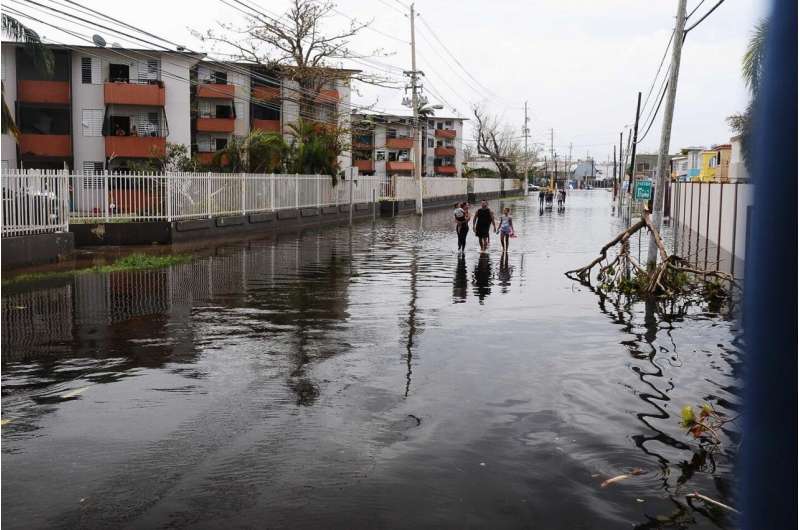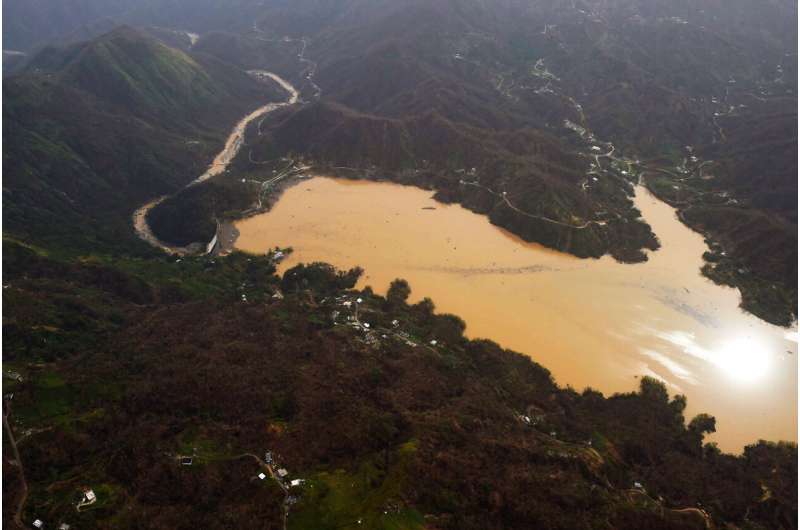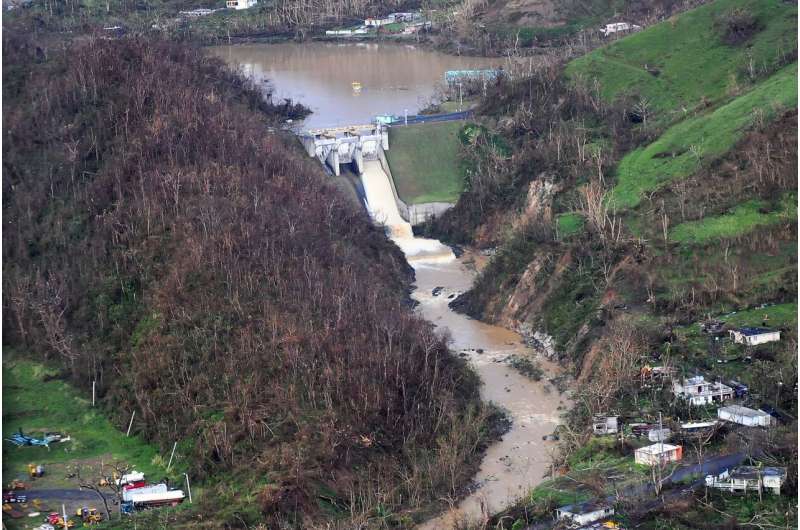Condado, San Juan, Puerto Rico. Credit: Sgt. Jose Ahiram Diaz-Ramos/PRNG-PAO
Puerto Rico is not ready for another hurricane season, let alone the effects of climate change, according to a new study that shows the island's outstanding capacity to produce record-breaking floods and trigger a large number of landslides.
The latest research, appearing in the journal Hydrology, builds on three prior studies led by hydrologist Carlos Ramos-Scharrón at The University of Texas at Austin, whose team began investigating the devastating impact of tropical cyclones on the island after Hurricane Maria in 2017.
The first compared the 2017 hurricane as a rainstorm event to more than a century of cyclones that came before it, finding that Maria produced the highest island-wide daily rainfall amount ever recorded (similar to Hurricane Harvey's impact on Houston). The second found that Maria's rainfall triggered one of the highest number of rainfall-induced landslides ever reported worldwide in similarly sized areas. And the third identified landslides as the main source of the sediment infilling the already limited water storage capacity of the island's main reservoirs.
"We need to stop talking about climate change in future tense. It's already here," said Ramos-Scharrón, associate professor in the Department of Geography and the Environment and the Teresa Lozano Long Institute of Latin American Studies. "Climate change projections for the Caribbean suggest longer dry periods interrupted by more intense storms. These storms release large quantities of sediment by landslides, and many of those end up reducing the island's capacity to store water. The combined effect of these climate change projections is for a higher propensity for water scarcity."
Civil Air Patrol in cooperation with the Air National Guard does an ariel survey over northern Puerto Rico Sept. 26, 2017 after hurricane Maria impacted the island on Sept. 20, 2017. The Civil Air Patrol is part of the Air Force's total force concept. Credit: US Air Force photo by Airman 1st Class Nicholas Dutton
The latest paper, which focused on streamflow levels, draws attention to another glaring issue—Puerto Rico is not prepared to handle the severe flooding sure to come its way. Flood management and the design of vital infrastructure, such as bridges, largely rely on a calculation of the likelihood that an event of a given magnitude is going to occur. For a particular region, that calculation depends on the history of flooding.
In Puerto Rico, the most current method to make such calculations relies on data collected only up to 1994. Since then, Hurricanes Hortense (1996), Georges (1998) and Maria surpassed both 100-year and 500-year flood marks across the island, with Maria surpassing 500-year levels in five locations.
The Adjuntant General of Puerto Rico, Brig. Gen. Isabelo Rivera, and State Command Sgt. Maj. Juvencio Méndez, along with the Governor of Puerto Rico, Hon. Ricardo Rosselló Nevares, and the Resident Commissioner of Puerto Rico in Washington, Hon. Jennifer González, the director of FEMA in Puerto Rico, Alejandro de la Campa, and the Director of the Authority of Electrical Energy of Puerto Rico, Eng. Ricardo Ramos, realized a reconnaissance flight of the island, Sept. 23, with aid from Puerto Rico National Guard Army Aviation, San Juan, P.R. Credit: Sgt. Jose Ahiram Diaz-Ramos/PRNG-PAO
Five other tropical storms matched or surpassed 100- and 500-year levels in some specific locations, particularly near the central-eastern end of Puerto Rico, which is most vulnerable due to the westward trajectory of most tropical cyclones and the island's hilly topography.
"Events with these 100- and 500-year metrics just cannot be that common," Ramos-Scharrón said. "If this is not what climate change is supposed to be, then I do not know what it is. It can creep up on you. Puerto Rico needs to adapt its planning tools to the reality of what the island has experienced and scientists are documenting."
More information: Carlos E. Ramos-Scharrón et al, A Catalogue of Tropical Cyclone Induced Instantaneous Peak Flows Recorded in Puerto Rico and a Comparison with the World's Maxima, Hydrology (2021). DOI: 10.3390/hydrology8020084
Provided by University of Texas at Austin
























